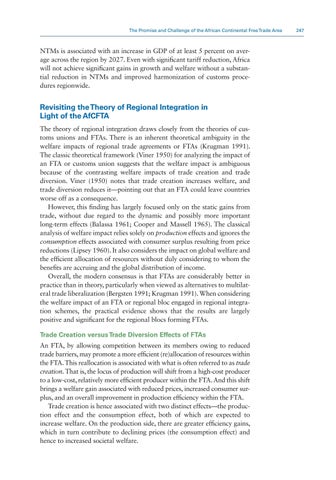The Promise and Challenge of the African Continental Free Trade Area 247
NTMs is associated with an increase in GDP of at least 5 percent on average across the region by 2027. Even with significant tariff reduction, Africa will not achieve significant gains in growth and welfare without a substantial reduction in NTMs and improved harmonization of customs procedures regionwide.
Revisiting the Theory of Regional Integration in Light of the AfCFTA The theory of regional integration draws closely from the theories of customs unions and FTAs. There is an inherent theoretical ambiguity in the welfare impacts of regional trade agreements or FTAs (Krugman 1991). The classic theoretical framework (Viner 1950) for analyzing the impact of an FTA or customs union suggests that the welfare impact is ambiguous because of the contrasting welfare impacts of trade creation and trade diversion. Viner (1950) notes that trade creation increases welfare, and trade diversion reduces it—pointing out that an FTA could leave countries worse off as a consequence. However, this finding has largely focused only on the static gains from trade, without due regard to the dynamic and possibly more important long-term effects (Balassa 1961; Cooper and Massell 1965). The classical analysis of welfare impact relies solely on production effects and ignores the consumption effects associated with consumer surplus resulting from price reductions (Lipsey 1960). It also considers the impact on global welfare and the efficient allocation of resources without duly considering to whom the benefits are accruing and the global distribution of income. Overall, the modern consensus is that FTAs are considerably better in practice than in theory, particularly when viewed as alternatives to multilateral trade liberalization (Bergsten 1991; Krugman 1991). When considering the welfare impact of an FTA or regional bloc engaged in regional integration schemes, the practical evidence shows that the results are largely positive and significant for the regional blocs forming FTAs. Trade Creation versus Trade Diversion Effects of FTAs An FTA, by allowing competition between its members owing to reduced trade barriers, may promote a more efficient (re)allocation of resources within the FTA. This reallocation is associated with what is often referred to as trade creation. That is, the locus of production will shift from a high-cost producer to a low-cost, relatively more efficient producer within the FTA. And this shift brings a welfare gain associated with reduced prices, increased consumer surplus, and an overall improvement in production efficiency within the FTA. Trade creation is hence associated with two distinct effects—the production effect and the consumption effect, both of which are expected to increase welfare. On the production side, there are greater efficiency gains, which in turn contribute to declining prices (the consumption effect) and hence to increased societal welfare.


